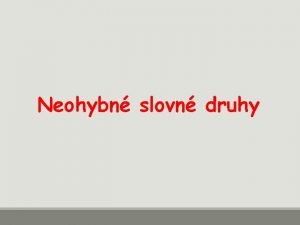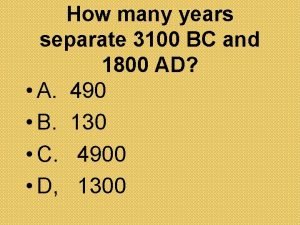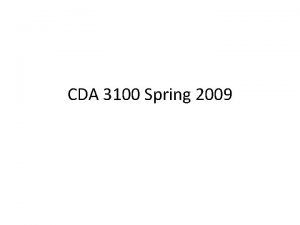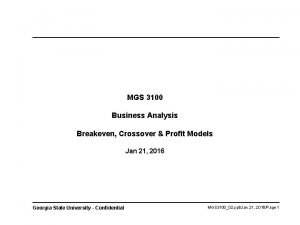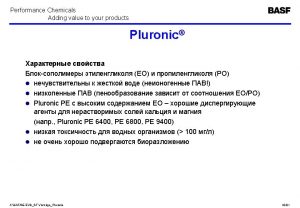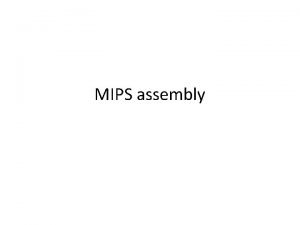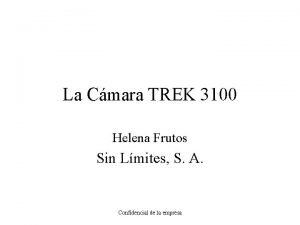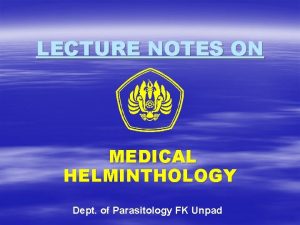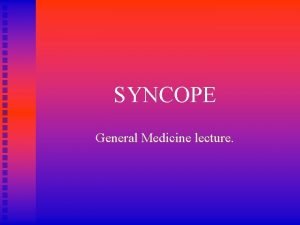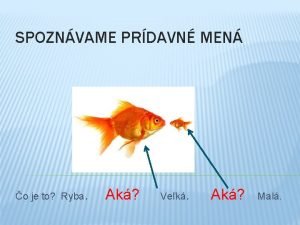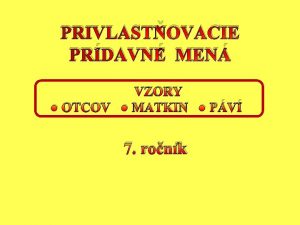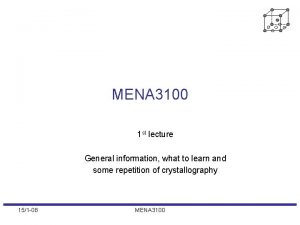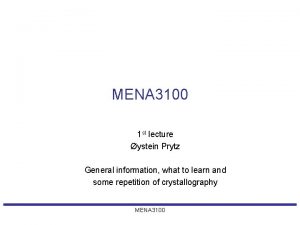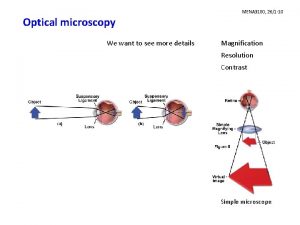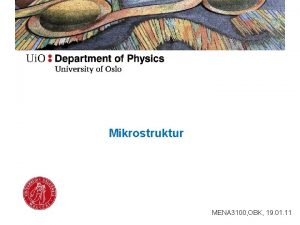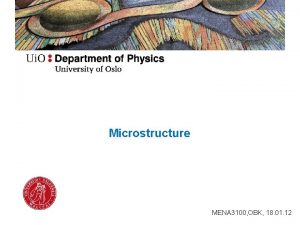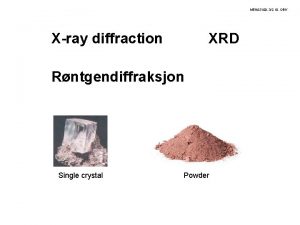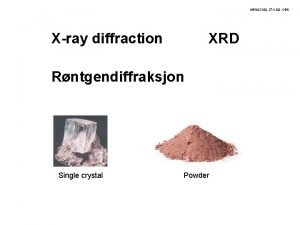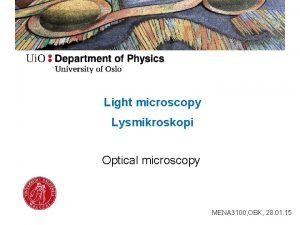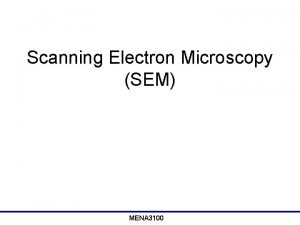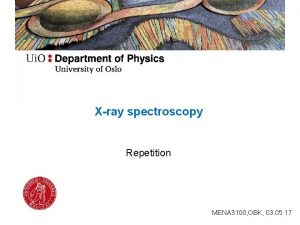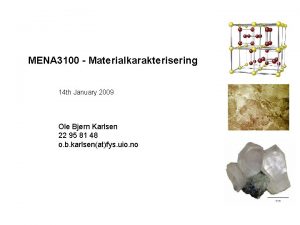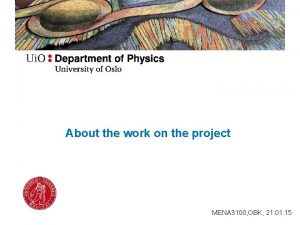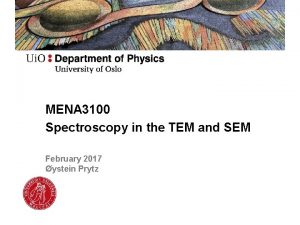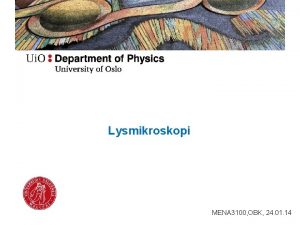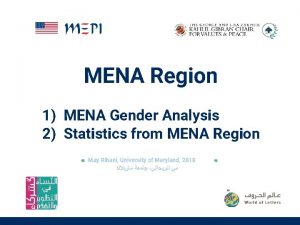MENA 3100 1 st lecture General information what

























- Slides: 25

MENA 3100 1 st lecture General information, what to learn and some repetition of crystallography 19/1 -10 MENA 3100

Student contact information Name 19/1 -10 E-mail Phone MENA 3100

Who is involved? • Anette E. Gunnæs: eleonora(at)fys. uio. no, 91514080 (General, TEM, ED) • • • Johan Taftø: johan. tafto(at)fys. uio. no (waves optics, TEM, EELS) Ole Bjørn Karlsen: obkarlsen(at)fys. uio. no (OM, XRD) Sissel Jørgensen: sissel. jorgensen(at)kjemi. uio. no (EDS, XPS) Spyros Diplas: spyros. diplas(at)smn. uio. no (XPS) Klaus Magnus Johansen: k. m. h. johansen(at)smn. uio. no (SIMS) Terje Finnstad: terje. finnstad(at)fys. uio. no (SPM) Oddvar Dyrlie: oddvar. dyrlie(at)kjemi. uio. no (SPM) Magnus Sørby: magnus. sorby(at)IFE. no (ND) Geir Helgesen: geir. helgesen(at)IFE. no (ND) Truls Norby: (SEM) 19/1 -10 MENA 3100

General information • Lectures – Based on D. Brandon and W. D. Kaplan "Microstructural characterization of materials". Second edition, published by Wiley, 2008. – The curriculum is made up of the whole book, except these chapters: 3. 4. 3, 3. 4. 4, 3. 4. 6, 7. 3 and 9. – Some parts of the Brandon and Kaplan book will be regarded as self study material – Lecture notes that are made available on the course webpage are also considered to be part of the curriculum. • Project work – – • Projects will be announced by the end of January/beginning of February Three students will work together, rank projects with 1 st-3 rd priority Written report, oral presentation and individual examination Counts 40 % of final grade Laboratories – Four groups: A, B, C, D (4 -5 students in one group) – Individual reports – All reports have to be evaluated and found ok before final written exam 19/1 -10 MENA 3100

Laboratory groups A C (Tue. 14. 15 - ) B (Tue. 16. 15 - ) (Wed. 10. 15 - ) D (Wed. 12. 15 - ) A trip to IFE, Kjeller has been scheduled to Wednesday 17 th of February! 19/1 -10 MENA 3100

What to learn about • Imaging/microscopy • – Optical – Electron Spectroscopy – EDS • X-rays – EELS • SEM • STEM • TEM • Electrons – XPS, AES – Scanning probe • Electrons (surface) • AFM • STM – SIMS • Ions Different imaging modes. • Diffraction – X-rays – Electrons Mapping of elements or chemical states of elements. • – – • ED in TEM and EBSD in SEM – Neutrons The same basic theory for all waves. 19/1 -10 Sample preparation MENA 3100 Mechanical grinding/polishing Chemical polishing/etching Ion bombardment Crunching etc……

Probes used • • Visible light – Optical microscopy (OM) • X-ray – X-ray diffraction (XD) – X-ray photo electron spectroscopy (XPS) • Neutron – Neutron diffraction (ND) • Ion – Secondary ion mass spectrometry (SIMS) – Cleaning, cutting and thinning samples 19/1 -10 MENA 3100 Electron – Scanning electron microscopy (SEM) – Transmission electron microscopy (TEM) – Electron holography (EH) – Electron diffraction (ED) – Electron energy loss spectroscopy (EELS) – Energy dispersive x-ray spectroscopy (EDS) – Auger electron spectroscopy (AES)

Basic principles, electron probe Electron Auger electron or x-ray Valence M M 3 d 6 3 p 4 3 d 4 2 p 2 Electron shell L 3 s 2 2 2 p 4 3 p 2 s 2 K L 1 s 2 K Secondary electron 19/1 -10 Characteristic x-ray emitted or Auger electron ejected after relaxation of inner state. Low energy photons (cathodoluminescence) when relaxation of outer stat. MENA 3100

Basic principles, x-ray probe X-ray Auger electron Valence Secondary x-rays M M Electron shell L K Photo electron 19/1 -10 Characteristic x-ray emitted or Auger electron ejected after relaxation of inner state. Low energy photons (cathodoluminescence) when relaxation of outer stat. MENA 3100

Basic principles X-rays Electrons (SEM) BSE X-rays (EDS) SE AE (XPS) Ions (XD) X-rays Ions (SIMS) AE PE (Also used for cleaning/thinning/cutting samples) SE E=Eo E<Eo (EELS) (TEM and ED) 19/1 -10 You will learn about: - the equipment -imaging -diffraction -the probability for different events to happen -energy related effects -element related effects -etc. , etc……. . MENA 3100

Introduction to crystallography We divide materials into two categories: – Amorphous materials • The atoms are ”randomly” distributed in space • Not quite true, there is short range order • Examples: glass, polystyrene (isopor) – Crystalline materials • The atoms are perfectly ordered • Short range and long range order • Deviations from the perfect order are important 19/1 -10 MENA 3100

Introduction to crystallography 19/1 -10 MENA 3100

Basic aspects of crystallography • Crystallography describes and characterise the structure of crystals • Basic concept is symmetry • Translational symmetry: if you are standing at one point in a crystal, and move a distance (vector) a the crystal will look exactly the same as where you started. b a a a 1 D a 19/1 -10 a 2 D a a MENA 3100 a

The lattice • described as a set of mathematical points in space – each of these points represents one or a group of atoms, basis Basis a a + Lattice a = crystal structure a 19/1 -10 a a MENA 3100

Axial systems The point lattices can be described by 7 axial systems (coordinate systems) z c β a x 19/1 -10 α γ b y Axial system Axes Angles Triclinic a≠b≠c α≠β≠γ≠ 90 o Monoclinic a≠b≠c α=γ=90 o ≠ β Orthorombic a≠b≠c α= β=γ=90 o Tetragonal a=b≠c α= β=γ=90 o Cubic a=b=c α= β=γ=90 o Hexagonal a 1=a 2=a 3≠c α= β=90 o γ=120 o Rhombohedral a=b=c α= β=γ ≠ 90 o MENA 3100

Bravais lattice The point lattices can be described by 14 different Bravais lattices Hermann and Mauguin symboler: P (primitiv) F (face centred) I (body centred) A, B, C (bace or end centred) R (rhombohedral) 19/1 -10 MENA 3100

Unit cell • The crystal structure is described by specifying a repeating element and its translational periodicity – The repeating element (usually consisting of many atoms) is replaced by a lattice point and all lattice points have the same atomic environments. – The unit cells are the smallest building blocks. – A primitive unit cell has only one lattice point in the unit cell. Repeating element, basis c α β γ b Lattice point a 19/1 -10 MENA 3100

Exaples of materials with a face centered cubic lattice Copper 19/1 -10 MENA 3100

Exaples of materials with a face centered cubic lattice Silicon 19/1 -10 MENA 3100

Exaples of materials with a face centered cubic lattice Zn. S 19/1 -10 MENA 3100

What about other symmetry elements? • We have discussed translational symmetry, but there also other important symmetry operations: – – – Mirror planes Rotation axes Inversion Screw axes Glide planes • The combination of these symmetry operations with the Bravais lattices give the 230 space groups 19/1 -10 MENA 3100

Space groups • Crystals can be classified according to 230 space groups. • Details about crystal description can be found in International Tables for Crystallography. – Criteria for filling Bravais point lattice with atoms. • • Structural data for known crystalline phases are available in books like “Pearson’s handbook of crystallographic data…. ” but also electronically in databases like “Find it”. • Pearson symbol like c. F 4 indicate the axial system (cubic), centering of the lattice (face) and number of atoms in the unit cell of a phase (like Cu). A space group can be referred to by a number or the space group symbol (ex. Fm-3 m is nr. 225) 19/1 -10 MENA 3100

Lattice planes • Miller indexing system z – Crystals are described in the axial system of their unit cell c/l – Miller indices (hkl) of a plane is found from the interception of the plane with the unit cell axis (a/h, b/k, c/l). a/h 0 b/k y x Z – The reciprocal of the interceptions are rationalized if necessary to avoid fraction numbers of (h k l) and 1/∞ = 0 (110) Y – Planes are often described by their normal Z Z (001) X (111) (010) – (hkl) one single set of parallel planes – {hkl} equivalent planes Y Y (100) X 19/1 -10 MENA 3100 X

Directions • • wc The indices of directions (u, v and w) can be found from the components of the vector in the axial system a, b, c. z [uvw] c The indices are scaled so that all are integers and as small as possible ua a b vb y x • Notation – [uvw] one single direction or zone axis – <uvw> geometrical equivalent directions • [hkl] is normal to the (hkl) plane in cubic axial systems 19/1 -10 Zone axis [uvw] (hkl) uh+vk+wl= 0 MENA 3100

Reciprocal vectors, planar distances –The normal of a plane is given by the vector: • The reciprocal lattice is defined by the vectors : a * = (b ´ c ) / V b * = (c ´ a ) / V –Planar distance between the planes {hkl} is given by: c * = (a ´ b) / V a*=(bcsinα)/V b*=(casinβ)/V –Planar distance (d-value) between planes {hkl} in a cubic crystal with lattice parameter a: 19/1 -10 MENA 3100 c*=(absinγ)/V
 Neplnovýznamové slovné druhy
Neplnovýznamové slovné druhy Iso 3100
Iso 3100 3100 bc in years
3100 bc in years Cda 3100 fsu
Cda 3100 fsu Mgs 3100
Mgs 3100 Emc vnxe 3100 manual
Emc vnxe 3100 manual Pluronic pe 3100
Pluronic pe 3100 Cda 3100
Cda 3100 Trek 3100
Trek 3100 Cs 3100
Cs 3100 Vgx-3100
Vgx-3100 01:640:244 lecture notes - lecture 15: plat, idah, farad
01:640:244 lecture notes - lecture 15: plat, idah, farad Wormhost chest worm locations
Wormhost chest worm locations Define distinguish
Define distinguish General parasitology lecture notes
General parasitology lecture notes Unified health management information system
Unified health management information system Diferencia entre gran plano general y plano general
Diferencia entre gran plano general y plano general Where did general lee surrender to general grant?
Where did general lee surrender to general grant? Podstatne mena pojmova mapa
Podstatne mena pojmova mapa Ema význam mena
Ema význam mena Pridavne mena otazky
Pridavne mena otazky Spocitajme sa
Spocitajme sa Pridavne mena opacneho vyznamu
Pridavne mena opacneho vyznamu Timea skloňovanie
Timea skloňovanie Pridavne mena individualne
Pridavne mena individualne Osobm
Osobm
